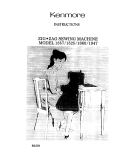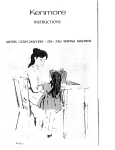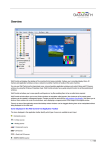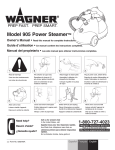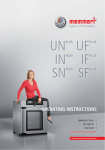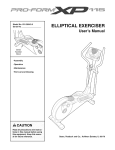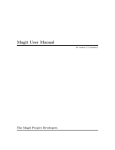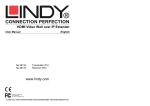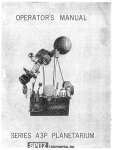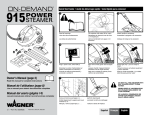Download JVC HAFX30A Headphones User Manual
Transcript
69565
TABLE OF CONTENTS
Knowing
Your Sewing
Machine
Identifying
Parts .................................
Connecting
Machine ..............................
1-2
3
Threading
- Bobbin ..............................
Top Thread ........................................
4 -5
6
Using the Controls
Top Tension Control
7 -8
...........................
Adjusting
Bobbin Tension
......................
Stitch Length Control ............................
Stitch Width Control .............................
Reverse Stitch Control
..........................
Feed Dog Control .................................
Special Stitch Dial ...........................
Pressure
Regulator
Sewing Light
Seam Guides
...............................
......................................
......................................
9
10
10
11
11
12- 14
15
16
17
Accessories
Needles
.............................................
Needle,
Thread,
Fabric
Chart
18
..................
19
Presser Feet ........................................
Buttonhole
Guide Feet ..........................
20
21
Zigzag and Straight
Stitching
Needle
Plate .................................................
22
Starting to Sew .....................................
Garment
Construction
Stitches
Straight
Stitching
Zigzag Stitching
Stretch Stitching
Special
Finishing
................................
..................................
............................
23
24
25
26 - 28
Stitches
Satin Stitching,
Appliqueing
...................
29
Buttonhole
Making .........................
30 - 32
Button Sewing,
Bar Tacking ...................
33
Blind Hemming
..................
: ...........
34 - 35
Zipper Application
................................
36
Special
Edge Stitch,
Checking
Performance
Mending,
Problems
Darning
..... 37
.........
39 - 40
Caring for the Machine
Cleaning Feed Dogs and Shuttle ................
Oiling Under Arm Cover Plate ....................
41
42
Oiling
43
Underside
....................................
Oiling Face Cover Plate ...........................
Parts List ........................................
69565
44
45 - 46
Knowing Your Sewing Machi
,--_1.
FRONT
VIEW
@
@
©
-@
@
®
®
®
®
®
®
_
@
@
(_'
.
11. Thread Guide
Box
2.
Hinged
Extension
12. Take-up
3.
Needle
Plate
13. Top Thread Tension
4.
Zigzag
5.
Presser
Foot
6.
Thread
7.
Stitching
Plate
14. Threading
Lever
Guide
Special Stitch Dial
Stitch Width Control
Thread
Guide
17.
Reverse Stitch
8.
Thread
Tension
9.
Thread
Guide
18.
19.
Stitch Length
Nomenclature
Face Cover
Plate
Regulator
Control
Path
15.
16.
10.
1
Accessory
Control
Control
Plate
BACK VIEW
r
@
®
@
.@
@
@
@
7
@
\
.@
@
®
/
26.
Bobbin
Winder
Connector
27.
Thread
Guide
22.
Hand
28.
Presser
Foot Lever
23.
Bobbin
Winder
Shaft
29.
Thread
Cutter
24.
Bobbin
Winder
Latch
30.
Needle
Clamp
25.
Thread
Spool
31.
Feed Dogs
20.
Light
21.
and Power
Switch
Wheel
Pin
Tension
Disc
Screw
2
CONNECTING
MACHINE
®
%
®
®
®
1. Lift hinged extension
at
side of machine bed-plate.
2.
the
left
For more sewing
space, tip the
bed plate cover
up by pushing
right edge as shown in Fig. 2.
Turn
the accessory
box toward
you as shown in Fig. 2.
3. Fig. 3. shows the machine ready
to sew with all the extensions
in
place for maximum sewing space.
3
4.
Push the
connector
column.
plug onto three-prong
at the back of machine
5.
Plug machine
cord into
120 volt wall
outlet.
power by pushing
switch.
6. Pull up spool
machine.
light
pin stored
any 110Turn on
and power
at top
of
_B
WINDING
THE BOBBIN
®
®
®
®
,
,
.
Draw thread from spool through
bobbin winder tension disc as shown
in Fig. 1.
Pull end of thread through hole in
bobbin
and
place
bobbin
onto
bobbin winder shaft with end of
thread coming from the top of the
bobbin,
fitting
the notch on the
bobbin over locking
stud on the
shaft as shown in Fig. 2.
Push bobbin winder
bobbin until it clicks.
latch
4.
Release clutch by pulling hand wheel
or turning clutch knob as shown in
Fig. 4. Start machine, holding onto
end of thread. When bobbin
is
slightly filled, release end of thread.
5.
When
bobbin
is
mechanism stops.
6.
Push in hand wheel or turning clutch
knob to return to stitching position.
Remove bobbin.
full,
winding
against
4
THREADING
THE BOBBIN
CASE
®
,j
i_
I
.
k
,.
\
®
®
®
®
®
1. To remove bobbin
case from the
shuttle,
raise needle to its highest
position.
2. Open bed plate cover,
accessory box.
,
4.
.
5
Pull open
latch
Pull bobbin
shuttle.
and remove
of bobbin
case
straight
case.
out
of
Insert bobbin into bobbin case making sure thread
is coming
from
bobbin as shown.
.
7.
Pull thread
shown.
Pull
thread
through
under
slot of case as
tension
8. Holding
latch open, position
into shuttle, and release latch.
should lock into place when
is released.
.
spring.
case
Case
latch
Hold needle thread loosely in left
hand and rotate hand wheel toward
you one complete turn. Bring bobbin thread
up by pulling
upper
thread.
THREADING
Model
OF TOP THREAD
1050
_
_
(_
d_
®
Model1020,
1030, 1040, 1045
(_/
®
6
TOP TENSION
Model
CONTROL
1050
Model1020,
1030, 1040, 1045
Probably the most important control on your machine is this one that regulates
your top thread tension. It consists of discs between which the thread passes.
The pressure on these discs is regulated
by turning the dial on the front of
the control.
The higher the number, the tighter the tension.
There
for
are many
one fabric
upon
fabric
the
reasons
may
stiffness
being
sewn,
not
for
having
be correct
of the
fabric,
as well
7
for
reset
your
another.
thickness
as the
It is best to test the stitching
starting to make a garment.
to
type
tension.
The
required
of the fabric,
of stitch
The
you
best
tension
numbers
tension
depends
of layers
of
are making.
on a scrap of the fabric you are using before
To adjust for the correct stitch, see next page.
ADJUSTING
TOP TENSIONS
A perfect straight stitch will have
threads locked between the two
layers of fabric with no loops on
top or bottom.
(_
Upper thread
too tight
Decrease
Tension
(_
Upper thread
too loose
Increase Tension
8
ADJUSTING
BOBBIN
Bobbin
tension.
requires
If the
tension
stitch
is satisfactory
loosen the tension
them as indicated
When adjusting
a screwdriver.
DECREASE
TENSIONS
adjusting
but
the
on both the top
on Page 9.
the tension
less
seam
frequently
is puckered,
and bottom
on the bobbin
than
it may
threads.
upper
be necessary
to
Be sure to balance
with
TENSION
Counter
Clockwise.
TENSION
Turn
9
thread
case, make slight adjustments
Turn
INCREASE
the
Clockwise.
STITCH
LENGTH CONTROL
The stitch length control located on the right side of the machine
the length of the stitch you select.
THE HIGHER THE NUMBER-THE
SHORTER
THE STITCH.
regulates
The stitch setting you use will be determined
by the thickness of the fabric
you are sewing.
A longer stitch setting should be used for thicker fabric
or more layers of fabric.
The middle range of the control
the most commonly
used.
A basting
per inch.
is the 10-1 2 stitch
per inch range which
stitch is made by using the longest possible
The marking _
such as in Satin
STITCH
on this control
Stitching.
WIDTH
is the setting
stitch setting
is
- 6 stitches
used for the shortest
stitches
CONTROL
I
m
ilmll
m
m
This control
NUMBER
regulates
- THE
by adjusting
this
This
must
control
the width
WIDER
control
be on
THE
of the
STITCH.
to the
Red
setting
Dot
stitch
you
select.
THE
You may vary your zigzag
you
in order
HIGHER
stitch
THE
width
desire.
to do straight
stitching.
10
REVERSE STITCH CONTROL
It is best to begin
is called
and
back
prevents
and end seams
tacking.
Back
with
tacking
a few
fastens
stitches
the
taken
ends
in reverse.
of the
seams
This
firmly
raveling.
When reverse stitching
is needed, turn the control
clockwise
there during sewing.
The fabric will immediately
start feeding
and seam will be fastened.
and hold
backwards
FEED DOG CONTROL
The feed dog control is located on the machine
behind accessory
box.
There are a few times when
you want to control
the feeding
of the
fabric yourself.
When the control is pushed down, the feed dogs drop and
do not move the fabric.
For most
up).
11
of your
sewing,
turn
the control
to the
up position.
(Feed
dog
SPECIAL
STITCH
DIAL
There are certain types of utility
stitches you will use often in your home
sewing.
This control enables you to just dial the stitch you need for the
task at hand.
THE RED DOT SETTING
The Red Dot setting illustrated
is the one used for most of your stitchingeither straight or simple zigzag.
When the stitch width is set on the Red
Dot and the Special Stitch Dial on the Red Dot setting, you may straight
stitch.
For a simple zigzag stitch, adjust the stitch width control
setting, with the dial remaining
on the Red Dot setting.
to the desired
12
SPECIAL
MENDING
STITCH
BLIND
STITCH
SETTING
You will
find that
much
of your
sewing is in the mending
category.
For this
reason
you
have
been
provided
with a stitch for the repair
of tears.
Use of the stitch
setting
shown is given in more detail in the
next section under Mending.
Blind
hems are made by using the
stitch setting shown in the illustration
above.
For more detailed instructions
in blind hemming,
see next section
of the book.
SPECIAL
ELASTIC
EDGE STITCH
STRETCH
STITCH
j
The setting
illustrated
is used for
special
edge
finishing,
combining
fabrics and so on. Details on the use
of this stitch are given
in the nextsection.
13
.
The setting
illustrated
is used for
special stretch stitch for sewing elastic
such as sportswear,
girdles and other
garments
that require stretch.
See
next section
of this book for detailed
use of the stitch.
OVERCAST
STRETCH
STITCH
SMOCKING
Overcast stretch stitching
is made by
using the stitch setting
shown in the
illustration
above.
Detaileg
instructions are given
the book.
STRETCH
in the
STITCH
next
section
of
SETTING
STRETCH
STITCH
You
can
make
smocking
stretch
stitching
by setting
the dial to the
setting
indicated
above.
See next
section
of this book for detailed use
of the stitches.
BUTTONHOLE
SETTING
I
Stretch
stitching
is easily
done by
setting the dial to the setting indicated
above.
Details on the use of this
stitch are given
of the book.
in the
next
section
The three settings shown
above are
used in making a bar tacked buttonhole.
Detailed instructions
are given
in the next section of the book.
14
OTHER
ADJUSTMENTS
OF SEWING
MACHINE
In addition to the obvious controls of your machine, there are other
regulators and controls to aid you in using your sewing machine.
PRESSURE
small
REGULATOR
Model1020,
1030, 1040, 1045
Model
1050
Fig. 2
Fig. 1
Push
down
pressure
the
outer
on the presser
To increase
obtained.
the
ring
foot.
pressure,
of
the
(See
push
pressure
regulator.
This
will
release
the
Fig. 1 above).
down
inner
pin
until
a suitable
pressure
is
The pressure on the presser foot is regulated by turning the dial of this regulator
which is situated in face cover plate (See Fig. 2 above). To increase the pressure,
turn the dial clockwise,
until a suitable
pressure is obtained.
Insufficient
pressure may cause poor feeding of the fabric, skipped stitches,
or difficulty
in guiding the fabric.
If feed dogs or presser foot marks appear
on the fabric, reduce the pressure.
When sewing multiple thickness or heavy fabric, reduce the pressure. Increase
pressure when sewing lighter weight fabrics.
15
SEWING
LIGHT
The light and power switch shown in
Fig. 1 provides the electric current for
the motor as well as for the light.
In order to operate the machine,
this
switch must be on. To turn on the light,
depress the upper side of the switch.
If you are interrupted
while sewing
and must leave the machine unattended, just turn off the switch and the machine cannot be started accidentally.
Fig. 1
The sewing light is located inside the
face cover plate as shown. To replace
the bulb, turn light off, and swing the
face cover plate open. Push up on the
bulb slightly and turn bulb clockwise.
Remove bulb from socket.
Push in
new bulb and turn counter-clockwise.
Fig. 2
16
SEAM
Seam
GUIDES
guides
are printed
on either
side
of the needle plate to aid you in guiding your
fabric.
THE GUIDE
LINE
EXTENDING
ABOVE
THE
RIGHT
SIDE
Cornering
Guide
OF
THE "ALL
LINE.
THE
NEEDLE
IMPORTANT"
PLATE
5/8"
IS
SEAM
The corneripg
guides are convenient
when turning a square corner 5/8"
from
the fabric
edge.
See next
section of this book for directions.
PRESSER FOOT LEVER
To aid you in the placement
fabrics under the presser foot,
can
"up"
raise
position.
changing
17
the
your
foot
beyond
This
presser
is also
feet.
of heavy
the lever
the
normal
an aid
in
NEEDLES
Use KENMORE
needles. The size of
the needle should conform
with the
size of the thread and both should be
suitable
to the fabric
I
I
II
I
i
j
II
I
(See next page).
Fig. 1
Never use a bent needle or one with
blunt point.
a
Fig. 1. shows you the exact length of
your needle.
Be sure you never use
one in your machine that is not this
exact length.
You will find among your accessories
a ..e x_:_:ll[,_:"_with blue shank.
This
special needle is to be used when
sewing
certain
knits
and
certain
difficult
synthetic
fabrics.
If you
experience
skipped stitches in any of
your sewing, use o x_:l-:l_[,_:.. .
PLACEMENT
OF NEEDLE
Raise needle bar to its highest position
by turning the hand wheel toward you.
Loosen the needle clamp screw. Holding the needle with the flat side away
from you, slip the needle into the
needle bar. When it is in as far as it
will go, tighten the needle clamp screw
with a screwdriver.
!'" l_l
''_
J
Flat
side
away
from
II
V
you.
18
NEEDLE,
THREAD,
THREAD
FABRIC
SIZE
NEEDLE
SIZE
Polyester Core/Cotton
Wrap
Fine Mercerized Cotton
Polyester
Silk A
Synthetic
50 Mercerized Cotton
Polyester Synthetic
Silk A
50 Mercerized
9orll
14
Cotton
Mercerized Heavy Duty
Polyester Synthetic
Silk A
Heavy Duty Mercerized
Polyester Synthetic
Silk A
Silk Buttonhole
CHART
Twist
Polyester Synthetic
50 Mercerized Cotton
Lightweight:
Batiste, Dimity,
Chiffon, Silks, Synthetic Jerseys,
Fine Lace, Organza, Crepe,
Taffetta, Voile, Organdy
Medium Weight:
Cotton, Cotton
Blends, Percale, Gingham,
Shantung,
Pique, Seersucker,
Satin, Knits, Vinyl, Suitings,
Linen, Wool Crepe, Leather
14 or 16
Medium Heavy Weight:
Corduroy,
Denim, Wool, Sailcloth, Wool
Flannel, Gabardine, Velvets,
Leather
18
Heavy Weight : Coatings,
Upholstery,
Cotton Duck, Heavy
Twills, Canvas
Cotton
16, 18 or
"Q NEEI)LE",=
"'0 SET",.
("Q NEEDLE",.
I
and
"Q FOOT",. )
19
FABRIC
Decorative
Top-stitching
on all
Synthetic
Knits and Stretch Fabrics:
Polyester Double Knits, Nylon
Tricot, Jersey, Stretch Terry,
Spandex, Cire Tricot
FASTENING
A SEAM
Be sure both threads are drawn back
under the presser foot.
Lower needle
into
fabric
about
1/2
inch
from
beginning
of seam.
Turn the reverse
stitch control clockwise
and stitch in
reverse until needle reaches beginning
of seam. Release control and complete
seam. When you reach the end, turn
the control clockwise
and sew back
over 1/2 inch of completed seam.
TURNING
-,.
_
_
•,,,
,
{,!-,
_ "_<,J
Corned
n
g
Guide
A SQUARE
CORNER
To turn a square corner 5/8"
from
the fabric edge, stop stitching
with
the needle tip piercing
the fabric,
when
reaching
the cornering
guide
as shown.
Raise the presser foot,
turn fabric.
New stitching
line will
align with 5/8"
seam guide on side
of needle plate. Lower the presser foot
and begin stitching
in new direction.
ZIGZAG STITCHING
SETTINGS
Special Stitch Dial - Red Dot
Stitch Width Control - 1 to 4
Stitch Length Control - Any Number
Zigzag Presser Foot
Use zigzag
needle plate.
This type of stitching
greatly expands
the use of your machine.
This is the
feature that enables you to overcast
seams, blind hem, applique,
buttonhole, monogram,
and make all the
pretty embroidery designs by machine.
Simply use the settings indicated
in
the illustration
for the simple zigzag.
Follow directions given in the following pages for more specific uses.
25
STRETCH STITCHING
The stitches
shown
below
are special
stitches
built
are all for use with stretch
in to the
machine
for your
and knit fabrics.
quick
selection.
\/X
1. Straight Stretch
2. Rick- Rack Stretch
|
These
A
/\/
\/
/\)
3. Smocking
Stretch
4. Elastic Stretch
5. Overcast Stretch
/ \/
|
\/\
/\/
\/\
/\/
\/\
/\/
\
db ®®
"-4
/\
®
®
STRAIGHT STRETCH
STITCHING
SETTINGS
Special Stitch Dial - _t_J
Stitch Width ControlRed Dot
Stitch Length Control - 8
Straight Stitch Foot
Use straight
stitching
Use this stretch
fabric and other
plate.
stitch
fabrics
with
that
knitted
stretch.
Sew as you do with regular straight
stitch
seaming.
The seam may be
pressed
open as with
any regular
seam, but will stretch if necessary.
This is also a good stitch to use on
curved seams regardless
of the type
of fabric.
Any seam that will receive
a great deal of strain
when
worn
should
be sewn
with
the stretch
stitch.
Use in children's
shorts and
slacks as well as adult sports clothes.
26
RICK-RACK
STITCHING
STRETCH
SETTINGS
Special Stitch Dial - III
Stitch Width Control - 1 to 4
Stitch Length Control - 8
Zigzag Presser Foot
Sew on stretch
fabrics in any area
that you might use a zig zag stitch.
This stitch can be used as a decorative
top stitch
as well.
SMOCKING STRETCH
STITCHING
SETTINGS
Step 1. Make a straight line of gathers across
the fabric that you wish to smock.
Step 2. Special Stitch Dial - 8_
Stitch Width Control - 3 to 4
Stitch Length Control - 8
Zigzag Presser Foot
With a narrow strip of fabric directly
under the line of gathering, stitch over
the gathers. The design will be a series
of small diamonds.
When smocking a garment, the stitching should be done before the piece is
sewn into the garment.
27
OVERCAST STRETCH
STITCHING
SETTINGS
Special Stitch Dial Stitch Width Control
Stitch Length Control
Zigzag Presser Foot
- 3 to 4
- 8
This is the same type of stitch used by
the garment industry in making sportswear. It is used for seams of 3/8" to
1/4". The seam is formed and finished
in one operation.
It must be used when
you are making swimwear,
ski pants
and other garments that require stretch.
Fig. 1 shows the raw edge finished.
Stitch so the needle pierces the fabric
just short of the outside edge.
Raw or worn edges of older garments
can be overcast
to prevent
further
raveling.
ELASTIC STRETCH
STITCHING
Fig. 1
SETTINGS
Special Stitch Dial - I_
Stitch Width Control
- 4
Stitch Length Control
Zigzag Presser Foot
- 8
This is a good stitch to use in making or
repairing lingerie. The stitch is decorative as well as useful. Simply
stitch
the elastic into place around the waist
of the garment, making sure that the
elastic is evenly spaced.
To do this
mark the correct
length
piece into
quarters
and match these markings
with center front and back of the garment as well as side seams.
28
SPECIAL
After the
finishing
Kenmore
done by
FINISHING
STITCHES
........
basic construction
of your garment is finished, there are still many
touches to be done. To aid your completion
of your garment, the
has been_designed to do the following
tasks that formerly had to be
hand.
SATIN STITCHING
SETTINGS
Special Stitch Dial - Red Dot
Stitch Width Control - Any Number 1 to 4
Stitch Length Control - Red Zone
Satin Stitch Foot
Use zigzag stitching
Closely spaced zigzag stitches are called satin stitches.
stitch used for appliqueing,
monogramming,
buttonhole
plate.
This is an attractive
making.
Whenever
you are using this stitch, it is well to remember to loosen the
tension of the top thread slightly.
The wider the stitch you make, the looser
the tension should be.
If you are stitching
on a very soft fabric, it is well to use a backing of tissue
paper or interfacing
for a well formed stitch. Puckering of the material will
be eliminated
and the bobbin thread will not be visible on the right side of
the fabric.
As with all special stitches, it is best to make a sample design
before starting the design on the garment.
on your fabric
APPLIOUEING
SETTINGS
Same as with Satin Stitching
Select an applique design to be applied
to your garment and baste it in place.
Satin stitch around the raw edge of
the applique completely
covering the
edge. You may want to do this with
a contrasting
color of thread or self
color.
29
BUTTONHOLE MAKING
SETTINGS
Stitch
Width
Control
- 4
Stitch Length Control
Zigzag Presser Foot
Use zigzag stitching
- Red Zone
plate.
1. Carefully
mark the position
and
length of each buttonhole
on your
garment.
Select the proper size
buttonhole
guide
foot to correspond with the length of buttonhole.
\
Fig. 1
2, Mount
the guide foot onto the
presser foot.
Holding
on to the
top thread, rotate the handwheel
toward
you one complete
turn.
Pull the upper thread under and
to the back of the buttonhole
guide
foot.
See Figs. 1 & 2.
3. Note in Fig. 3 that each guide
foot has a dot on the right ed;_
toward the back of the foot, and
on the left edge near the front of
the foot. These dots are used as a
point of reference for your bartacking steps in buttonholing.
(See
next page).
4. Slide the guide foot forward
until
the rear edge of the presser foot
is at the rear edge of the guide.
5. Place the fabric with the marked
buttonhole
under the guide foot.
Lower the presser foot lever and
follow
steps on next page.
(Check Hints for Perfect
holes on Page 32.)
g. 2
Hinge
Fig. 3
Button-
3O
|
Step
1
Step
2
1. Set special stitch dial at r'l and bartack
several times at the marked
beginning
of the buttonhole.
Stop sewing
at the left stitch.
Raise
needle
to its highest
position
by turning
handwheel
toward
you
manually.
2. Set special stitch dial at "iq.
Stitch forward until the hinged
the presser foot aligns with the dot on the left side of the
guide foot. The toe of the presser foot will be touching
the
guide foot.
Stop sewing at the left stitch and raise needle to
position as in Step 1.
Step
31
Step
3
3. Set special stitch dial at E] again and
needle at its highest position as in steps
4.
portion of
buttonhole
end of the
its highest
bartack
1 & 2.
several
times.
4
Raise
Set special
stitch dial at G. and continue
sewing
until the hinged
portion of the presser foot aligns with the dot on the right side of the
guide foot.
You will have reached the bartacking
done in Step 1.
HINTS FOR PERFECT
BUTTONHOLES
<
<
Start
The presser
foot
and
buttonhole
guide foot should be in this position
at the start of the buttonhole
sewing.
The needle must be lowered
at the
marked line for the beginning
of the
buttonhole.
See Fig. 1.
/
be in
presser
foot
position
buttonhole
To make
and
guide
shown
in
Fig.
foot
will
<
<
<
<
<
<
<
When the full length of the buttonhole is reached, the presser foot and
guide foot will be in position shown
in Fig. 2.
The
<
<
Fig. 1
REAR
1 when
is completed.
firm
well
stitched
button-
holes in heavier fabrics, repeat only
steps 1 and 3 on the preceding
page.
Fig. 2
If the forward
stitching
does not
exactly
match
the reverse stitching
as shown in Fig. 3, slightly adjust the
stitch length
control
during
forward
sewing.
Always
make a practice
buttonhole
on a scrap of fabric you plan to use.
Try the buttonhole
with the button you
will use.
Use an interfacing
between the layers
of fabric
tissue paper can be used
and torn away after the stitching.
1
,
Fig. 3
32
BUTTON SEWING
SETTINGS
Special Stitch Dial - Red
Feed DogsDown
Zigzag
Presser
Dot
Foot
Use zigzag stitching
plate.
1. Align two holes of button with slot
of presser foot and lower foot to
hold the button securely.
2. Turn hand wheel manually
until
neeclle point is just above button.
3. Adjust
needle
button.
stitch
width
will enter left
control
so
hole of the
4. Turn hand wheel again by hand so
needle enters second hole.
Readjust stitch width
if necessary.
Stitch a number of times.
5. Finish sewing with an extra two
inches of thread remaining.
Draw
these threads to reverse side of
garment and tie.
BAR TACKING
SETTINGS
M
Special Stitch Dial - Red Dot
Stitch Width Control - 2 to 4
m
w
Stitch Length Control - Red Zone
Zigzag Presser Foot
Use zigzag stitching
!
I
I
!
!
I'
!
I
!
!
!
33
o!
plate.
This stitch is similar to a very short
satin stitch and is used to reinforce
points of strain such as corners of
pockets and straps on lingerie.
Sew 4 to 6 zigzag stitches.
BLIND
HEMMING
SETTINGS
Special Stitch DialStitch Width Control - 2 to 3
Stitch Length Control - 12 to 10
Zigzag foot or blindstitch
Use zigzag stitching
After
guide
plate.
you have turned
up the hem width
Fig.
1 Raw
edge fold
desired,
turn raw edge over 1/2"
and
stitch
this fold with
a basting
stitch
Press.
Fold
hem
back
against
garmet with basted
about 1/8" to right
right
side
of
Fig. 2 Hem folded back
raw edge extending
of garment
fold.
34
Fig. 3 Fabric
placed
in blindstitch
Fig. 4 Stitching
stitch.
along
Fig. 5 Finished
hem
garment.
35
fold
on
with
right
guide.
Place the fold of the hem in the
slots of the attachment
for
guiding the fabric. Make certain
zigzag stitch catches the fold of
by adjusting
the
blindstitch
slightly from left to right.
two left
ease in
that the
the hem
guide
blind
side
of
Remove
basting
and press hem. Right
side of garment
will show only the blind
stitches as in Fig. 5.
ZIPPER APPLICATION
SETTINGS
Special Stitch Dial - Red Dot
Stitch Width Control
- Red Dot
Stitch Length
Foot
Control - 12 to 10
Zipper
Use straight
stitching
REGULAR
The
foot
right
is adjustable
side
for
of the
the regular
type
the foot
so the
the side
Carefully
the
ZIPPER
or left
sewing
Adjust
plate.
the
when
of zipper.
needle
clears
notch on the foot.
follow
directions
zipper
use on
needle
See Fig. 1.
given
on
package.
Fig. 1
INVISIBLE
ZIPPER
Adjust the foot so the needle is sewing
through
the center hole of the foot and
one groove
of the foot
teeth of the zipper.
See Fig.
facturer's
2. Follow
instructions.
the
is riding
zipper
on the
manu-
After zipper has been inserted, finish
sewing seam by shifting
foot to side
position
sewing through
side notch.
Fig, 2
CORDING
Foot can also be. used to make cording
for slipcovers etc. Cover a cord with
a strip of bias fabric and sew as shown
in Fig. 3.
Fig. 3
36
SPECIAL EDGE STITCH
SETTINGS
Special Stitch Dial Stitch
Width
Control-
Stitch Length ControlZigzag Presser Foot
Use zigzag stitching
1 to 4
Red Zone
plate.
This is an attractive overcasting stitch
you may want to use on fabrics that
fray easily.
MENDING
SETTINGS
.;._._._._._.;.:.:._
_.,:.:-:._._._,:.'-_,'-'.'.'.'.'.'-'-'.','.'.
- -....
-.......q;
Special Stitch Dial - ?.:
Stitch Width Control - 4
Stitch Length Control - Red Zone
Zigzag Presser Foot
Use straight
.* ,,.,-
*., ,.,,,,,
...
• ,, .>. -., *.
,...,
* • .,,,.+.::,.:,.:,.
stitching
plate.
,.,
To repair a straight or three-cornered
tear, position the tear under the needle
in such a way that the stitching catches
both sides of the tear. When mending
a three-cornered
tear, stitch from each
end to the center.
It is well to use a
:::::-:::.:.:.:.:._ :.:.:.::.:
piece of fabric under the tear for re::::::::::::::::::::::::::::::::::::::::::::::::::::::::::::::::::::::::::::::
inforcement.
,,*.,.,*,,,,.,
•..,,
• • ...,,..
,...,
[iiii!i!iiiiiii!!iiiiiiii!iiiii!!iii!!]iii[ii[i!i]i
"i'_.:'2.1.2._.:.i.2,[,;
'.'.'.'.'.'.'.'.'.','.'.'.'.'.','.'.'.'.'.'.'.'.'.-
DARNING
SETTINGS
Special Stitch Dial - Red Dot
Stitch Width Control - Red Dot
Pressure Regulator - 0
Feed Dogs - Up
No Presser Foot
37
Remove presser foot, stretch fabric between
embroidery
hoops with
hole
centered.
Draw the bobbin thread up
through the fabric by holding the top
thread and taking one stitch at the spot
where
you wish
to start darning.
Lowering the presser bar, start sewing
at a slow to medium speed. Move the
fabric back and forth with a steady
rhythm
to cover the darning
area.
When it is covered, turn the fabric and
sew another layer of stitching
across
the first layer of stitching.
38
_0
3. Checking Performance Problems WHAT TO DO
PROBLEM
PROBABLE
Incorrect
CORRECTION
Choose
size needle.
Improper threading.
Loose upper thread
Pulling fabric.
Irregular
Stitches
CAUSE
correct
Rethread
tension.
Light pressure on presser
Loose presser foot.
foot.
Unevenly
wound
bobbin.
Nicks or burrs on shuttle.
Nicks or burrs at hole of needle
size needle
for thread
and fabric.
machine.
Tighten
upper thread tension.
Do not pull fabric; guide it gently.
Increase pressure on presser foot.
Reset presser foot.
Rewind
bobbin.
Replace
shuttle,
Replace
needle
or polish
plate,
off
burrs
or polish
off
completely.
burrs
completely.
plate.
Breaking
Needle
Bunching
Thread
of
Pulling fabric.
Incorrect size needle.
Do not pull fabric; guide it gently.
Choose correct size needle for thread
Incorrect setting of needle.
Loose presser foot.
Reset
Upper and lower threads
not drawn
back under presser foot before
When starting
a seam be sure to draw both threads
back of presser foot about 4" and hold until a few
are formed.
starting
Incorrect
Puckering
thread
tension(s).
Light pressure on presser
Using two different
sizes
of thread.
Bent or blunt needle.
Loose
Fabric
Reset presser
seam.
foot.
or kinds
presser foot.
too sheer or too soft.
and fabric.
needle.
foot.
Reset thread tension(s).
Increase pressure on presser
foot.
Upper thread and bobbin thread should
Insert
new
needle.
Reset presser
Use underlay
foot,
of tissue
paper.
under and
stitches
be same size and kind.
PROBLEM
PROBABLE
Incorrect
Skipping
Stitches
Breaking Upper
Thread
CAUSE
size needle.
Certain knits and synthetics.
Bent or blunt needle.
Incorrect
setting
Tight
upper
Light
pressure
of needle.
thread
on
tension.
presser
foot.
Fabric not
Moving
Machine Jamming
Knocking
Noise
Choose correct size needle for thread
Use "Q NEF, I)I,E",_.
Insert
Reset
Loosen upper thread tension.
Increase pressure on presser foot.
Start to stitch at a medium
Rethread machine.
Sharp eye in needle.
Nicks or burrs on shuttle.
Nicks or burrs at hole of needle
Insert
Loosen
Choose
speed.
upper thread tension.
correct size needle for thread
shuttle,
or polish
off burrs
Feed dog down.
Light pressure on presser foot.
Raise feed dog.
Thread caught in shuttle.
completely.
Replace needle plate, or polish off burrs completely.
Check bobbin case threading.
Loosen bobbin thread tension.
Clean bobbin case and shuttle.
under fabric.
and fabric.
new needle.
Replace
Improper bobbin case threading.
Tight bobbin thread tension.
Lint in bobbin case or shuttle.
Thread knotted
and fabric.
new needle.
needle.
Starting to stitch too fast.
Improper threading.
Tight upper thread tension.
Incorrect size needle.
plate.
Breaking Bobbin
Thread
CORRECTION
Increase pressure on presser foot.
Place both threads back under presser
beginning
foot
before
to stitch.
Disassemble and clean shuttle.
4:=
O
[]
Caring for the Machine
CLEANING
AND
Fig. 1 Cleaning
brush•
OILING
the feed dogs with
a
To insure the best possible operation
of your machine,
it is necessary to
keep the essential parts clean at all
times•
Using a small brush, remove
the lint that accumulates
in the shuttle
1
area and around
the feed dogs.
Fig. 2 Parts of the Shuttle
Clean the Shuttle
To
lever--_
.-,---lever
Shuttle
Area:
1. This area must be kept free of dust,
lint and occasional tangled thread.
Raise the needle bar to its highest
point and remove the bobbin case.
Push levers of shuttle race aside
and lift shuttle race cover and shuttle out.
,
Assembly
Assembly
3. Clean the
brush.
shuttle
race with
small
Put a drop of oil on the center pin
of the shuttle
and shuttle
race.
,
(see arrows)
Shuttle
Race
Cover
To Replace
onted
hook
Shuttle
driver
,
Position
Shuttle
shuttle
Assembly:
race
as illustrated
so that
shuttle
driver
half moon on the left
machine•
•
Hold shuttle by center pin and position shuttle so as to form a half
moon on the right side.
Pointed
hook will be on the bottom.
3. Place shuttle race cover
over shuttle assembly•
Shuttle
41
Race
Fig. 2
is forming
side of tile
into place
OILING
UNDER
ARM
COVER
Remove arm cover plate to oil points
To remove cover plate lift cover.
PLATE
indicated
in top
of machine
head.
42
OILING
UNDERSIDE
Tilt machine
underside
(C),
(D)
head
and
(E)
B
43
back and remove
of machine.
To
remove
as shown
below.
bottom
cover to oil points
bottom
cover,
remove
indicated
screws
(A),
on
(B),
OILING
IN FACE
COVER
Swing hinged face cover plate
points indicated in illustration.
PLATE
open
and
remove
arm cover
plate to oil
SEWING
Now
MACHINE
that
you
have
purchased
your
Sewing
Machine,
need ever exist for repair parts or service,
simply
Sears Service
Center
and most Sears,
Roebuck
Simpsons-Sears
Limited
Stores.
Be sure to provide
facts
when
you
The model
number
of your
WHEN
ORDERING
REPAIR
FOLLOWING
INFORMATION:
NUMBER
If the parts
electronically
Center
for
SEARS,
S - 158
a
contact
any
and Co. or
all pertinent
call or visit.
Sewing
Machine
will
your nomenclature
plate on the right
side
Machine.
See Section
1, page 3 for location.
*MODEL
should
*NAME
PARTS,
OF ITEM
you need are not stocked
transmitted
to a Sears
of
ALWAYS
*PART
locally,
Repair
be shown
your
on
Sewing
GIVE
THE
DESCRIPTION
your order will be
Parts Distribution
handling.
ROEBUCK
AND
CO.,
Chicago,
IL 60684 U.S.A.
Part No. 69565
11/91














































